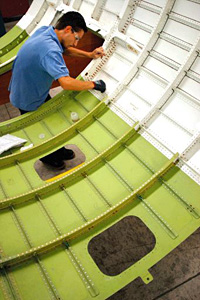 |
 |
 |
 Business News | May 2007 Business News | May 2007  
Mexico Takes Cue from Canada
 Marla Dickerson & Carlos Martinez - LATimes Marla Dickerson & Carlos Martinez - LATimes


| | Bombardier runs new complex in Queretaro, Mexico |
Queretaro, Mexico - Building jet airplanes has long been the domain of advanced industrial nations. Now Mexico is trying to join the club by hitching a ride with a Canadian aerospace company.

Montreal-based Bombardier Aerospace broke ground this month in this central Mexican city on a massive complex to build wiring harnesses, fuselages and flight controls. The company, best known for its Learjets and other executive jets, already employs 450 workers here. It plans to have 1,200 by the end of next year.

Since it began production in temporary quarters in May 2006, Bombardier has hit the throttle. Its Mexican employees are cranking out sub-assemblies such as tail rudders and stabilizers two years before the company had planned.

Mexican officials project Bombardier will start assembling complete planes here within five years. Company officials won't make any promises. But it's clearly on their radar screen.

"There is no doubt in my mind that if we stay focused the way we are now ... that (Mexico) can do the same as we do in Canada or Europe or the United States," said Real Gervais, director general of Bombardier's Mexican operations.

Industry experts are dubious. Some suspect Bombardier's talk of building aircraft here is a ruse to keep Canadian unions in line.

But if it comes to pass, Mexico would be one of the few developing nations doing final assembly of sophisticated planes.

"This is the great objective that we all have, not only Queretaro, but the nation," said Renato Lopez Otamendi, secretary of sustainable development for the state of Queretaro.

Mexico's aerospace industry comprises about 125 companies and 16,500 workers, most in the northern part of the country. Once little more than a low-cost job shop for U.S. aerospace suppliers, Mexico is handling increasingly sophisticated tasks.

A General Electric subsidiary employs 500 aerospace research and development workers in Queretero. McDonnell Douglas is manufacturing helicopter fuselages in Monterrey. Some large aircraft maintenance operations are setting up shop. U.S. imports of Mexican aerospace products totaled nearly $178 million last year, up 60 percent from 2000. Total aerospace exports topped $500 million in 2006, according to Mexico's Economy Secretariat.

Getting better

Government officials want to keep Mexico moving up the supply chain. While it has no ambitions to launch its own national program, as China is planning, it wants more high-value tasks from big companies, including structure and design work and final assembly.

"The big challenge for our country is to move toward a technology economy, toward a knowledge-based economy," said Eduardo Solis, head of investment promotion for Mexico's Economy Secretariat.

Mexico doesn't have much choice. It's fast losing basic industries such as textiles to nations with cheaper labor. So Mexico is looking to capitalize on its success at building products such as automobiles.

Aerospace carries a special cache. The industry has a huge "pulling" effect on other industries such as electronics and metallurgy. Countries that can build something as complex as a jetliner are viewed as having their industrial act together.

"It's a big deal," said consultant John Walsh of Maryland-based Walsh Aviation. "But there are a lot of hurdles to getting into the big leagues."

Developing countries produced less than 10 percent of the aerospace parts imported by the U.S. last year, according to U.S. government figures.

Challenges ahead

Still, developing nations see opportunities. Despite previous failed efforts, China plans to develop large cargo and passenger aircraft to serve its burgeoning aviation market. Brazil's Embraer has made a global splash with its small regional jets.

Embraer's biggest competitor is Bombardier. The Canadian company is the world's No. 3 aircraft maker behind Boeing and Airbus. Its main products are business jets, which are experiencing soaring demand, and regional jets, a segment that is struggling. The company has laid off thousands of workers in recent years and is under pressure to reduce costs. That was a major factor in its decision to put a facility in Mexico.

Bombardier's interest in Mexico began with former Mexican President Vicente Fox, who persuaded company officials to consider including his nation in their global manufacturing network. After a lengthy search, Bombardier in late 2005 settled on Queretaro, an industrial hub of 1.6 million 140 miles northwest of Mexico City. It is home to a number of research centers and multinationals attracted by its solid universities and educated work force.

The city's international airport, which opened in 2004, was a particular attraction for Bombardier. That's where it is building its new complex, part of the company's plans to invest $200 million in Mexico by 2016. | 
 | |
 |



